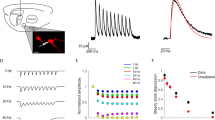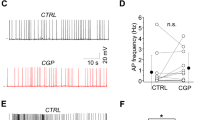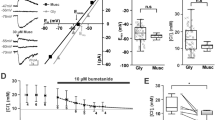Abstract
GABA (γ-aminobutyric acid) is predominantly released by local interneurons in the cerebral cortex to particular subcellular domains of the target cells1,2. This suggests that compartmentalized, synapse-specific action of GABA is required in cortical networks for phasic inhibition2,3,4. However, GABA released at the synaptic cleft diffuses to receptors outside the postsynaptic density and thus tonically activates extrasynaptic GABAA and GABAB receptors, which include subtypes of both receptor families especially sensitive to low concentrations of GABA3,4,5,6,7. The synaptic and extrasynaptic action of GABA corroborates the idea that neurons of the brain use synaptic (or wiring) transmission and non-synaptic (or volume) transmission for communication8,9. However, re-uptake mechanisms restrict the spatial extent of extrasynaptic GABA-mediated effects10,11, and it has been proposed that the concerted action of several presynaptic interneurons, the sustained firing of individual cells or an increase in release-site density is required to reach ambient GABA levels sufficient to activate extrasynaptic receptors4,9,11,12,13. Here we show that individual neurogliaform cells release enough GABA for volume transmission within the axonal cloud and, thus, that neurogliaform cells do not require synapses to produce inhibitory responses in the overwhelming majority of nearby neurons. Neurogliaform cells suppress connections between other neurons acting on presynaptic terminals that do not receive synapses at all in the cerebral cortex. They also reach extrasynaptic, δ-subunit-containing GABAA (GABAAδ) receptors responsible for tonic inhibition. We show that GABAAδ receptors are localized to neurogliaform cells preferentially among cortical interneurons. Neurosteroids, which are modulators of GABAAδ receptors, alter unitary GABA-mediated effects between neurogliaform cells. In contrast to the specifically placed synapses formed by other interneurons, the output of neurosteroid-sensitive neurogliaform cells represents the ultimate form of the lack of spatial specificity in GABA-mediated systems, leading to long-lasting network hyperpolarization combined with widespread suppression of communication in the local circuit.
This is a preview of subscription content, access via your institution
Access options
Subscribe to this journal
Receive 51 print issues and online access
$199.00 per year
only $3.90 per issue
Buy this article
- Purchase on Springer Link
- Instant access to full article PDF
Prices may be subject to local taxes which are calculated during checkout



Similar content being viewed by others
References
Freund, T. F. & Buzsaki, G. Interneurons of the hippocampus. Hippocampus 6, 347–470 (1996)
Klausberger, T. & Somogyi, P. Neuronal diversity and temporal dynamics: the unity of hippocampal circuit operations. Science 321, 53–57 (2008)
Farrant, M. & Nusser, Z. Variations on an inhibitory theme: phasic and tonic activation of GABA(A) receptors. Nature Rev. Neurosci. 6, 215–229 (2005)
Glykys, J. & Mody, I. Activation of GABAA receptors: views from outside the synaptic cleft. Neuron 56, 763–770 (2007)
Nusser, Z., Sieghart, W. & Somogyi, P. Segregation of different GABAA receptors to synaptic and extrasynaptic membranes of cerebellar granule cells. J. Neurosci. 18, 1693–1703 (1998)
Fritschy, J. M. & Brunig, I. Formation and plasticity of GABAergic synapses: physiological mechanisms and pathophysiological implications. Pharmacol. Ther. 98, 299–323 (2003)
Moss, S. J. & Smart, T. G. Constructing inhibitory synapses. Nature Rev. Neurosci. 2, 240–250 (2001)
Vizi, E. S. Role of high-affinity receptors and membrane transporters in nonsynaptic communication and drug action in the central nervous system. Pharmacol. Rev. 52, 63–89 (2000)
Barbour, B. & Hausser, M. Intersynaptic diffusion of neurotransmitter. Trends Neurosci. 20, 377–384 (1997)
Guastella, J. et al. Cloning and expression of a rat brain GABA transporter. Science 249, 1303–1306 (1990)
Overstreet, L. S. & Westbrook, G. L. Synapse density regulates independence at unitary inhibitory synapses. J. Neurosci. 23, 2618–2626 (2003)
Scanziani, M. GABA spillover activates postsynaptic GABA(B) receptors to control rhythmic hippocampal activity. Neuron 25, 673–681 (2000)
Mitchell, S. J. & Silver, R. A. GABA spillover from single inhibitory axons suppresses low-frequency excitatory transmission at the cerebellar glomerulus. J. Neurosci. 20, 8651–8658 (2000)
Tamás, G., Lorincz, A., Simon, A. & Szabadics, J. Identified sources and targets of slow inhibition in the neocortex. Science 299, 1902–1905 (2003)
Szabadics, J., Tamas, G. & Soltesz, I. Different transmitter transients underlie presynaptic cell type specificity of GABAA,slow and GABAA,fast . Proc. Natl Acad. Sci. USA 104, 14831–14836 (2007)
Price, C. J., Scott, R., Rusakov, D. A. & Capogna, M. GABA(B) receptor modulation of feedforward inhibition through hippocampal neurogliaform cells. J. Neurosci. 28, 6974–6982 (2008)
Karube, F., Kubota, Y. & Kawaguchi, Y. Axon branching and synaptic bouton phenotypes in GABAergic nonpyramidal cell subtypes. J. Neurosci. 24, 2853–2865 (2004)
Markram, H. et al. Interneurons of the neocortical inhibitory system. Nature Rev. Neurosci. 5, 793–807 (2004)
Simon, A., Olah, S., Molnar, G., Szabadics, J. & Tamas, G. Gap-junctional coupling between neurogliaform cells and various interneuron types in the neocortex. J. Neurosci. 25, 6278–6285 (2005)
Peters, A. P., Palay, S. L. & de F. Webster, H. The Fine Structure of the Nervous System (Oxford Univ. Press, 1991)
Isaacson, J. S., Solis, J. M. & Nicoll, R. A. Local and diffuse synaptic actions of GABA in the hippocampus. Neuron 10, 165–175 (1993)
Sakaba, T. & Neher, E. Direct modulation of synaptic vesicle priming by GABA(B) receptor activation at a glutamatergic synapse. Nature 424, 775–778 (2003)
Guetg, N. et al. The GABAB1a isoform mediates heterosynaptic depression at hippocampal mossy fiber synapses. J. Neurosci. 29, 1414–1423 (2009)
Pearce, R. A. Physiological evidence for two distinct GABAA responses in rat hippocampus. Neuron 10, 189–200 (1993)
Kulik, A. et al. Subcellular localization of metabotropic GABA(B) receptor subunits GABA(B1a/b) and GABA(B2) in the rat hippocampus. J. Neurosci. 23, 11026–11035 (2003)
Vardya, I., Drasbek, K. R., Dosa, Z. & Jensen, K. Cell type-specific GABA A receptor-mediated tonic inhibition in mouse neocortex. J. Neurophysiol. 100, 526–532 (2008)
Stell, B. M., Brickley, S. G., Tang, C. Y., Farrant, M. & Mody, I. Neuroactive steroids reduce neuronal excitability by selectively enhancing tonic inhibition mediated by delta subunit-containing GABAA receptors. Proc. Natl Acad. Sci. USA 100, 14439–14444 (2003)
Brickley, S. G., Revilla, V., Cull-Candy, S. G., Wisden, W. & Farrant, M. Adaptive regulation of neuronal excitability by a voltage-independent potassium conductance. Nature 409, 88–92 (2001)
Chadderton, P., Margrie, T. W. & Hausser, M. Integration of quanta in cerebellar granule cells during sensory processing. Nature 428, 856–860 (2004)
Kullmann, D. M. et al. Presynaptic, extrasynaptic and axonal GABAA receptors in the CNS: where and why? Prog. Biophys. Mol. Biol. 87, 33–46 (2005)
Acknowledgements
The authors thank W. Sieghart for donating antibody, A. Lőrincz and Z. Nusser for initial testing of the GABAAδ antibody, I. Mody for the GABAAδ -/- animals, and A. Simon and E. Tóth for reconstructions. This work was supported by the European Young Investigator Award, the Hungarian National Office for Research and Technology Polányi Award, the Howard Hughes Medical Institute, US National Institutes of Health grant NS535915, the Boehringer Ingelheim Fonds and the Hungarian Academy of Sciences.
Author Contributions S.O. performed experiments, analysed data and wrote the paper; M.F., G.K., C.V. and R.B. performed experiments and analysed data; P.B. performed experiments; and G.T. designed and performed experiments, analysed data and wrote the paper.
Author information
Authors and Affiliations
Corresponding author
Supplementary information
Supplementary Information
This file contains Supplementary Notes, Supplementary Figures 1-7 with Legends and Supplementary References. (PDF 603 kb)
Rights and permissions
About this article
Cite this article
Oláh, S., Füle, M., Komlósi, G. et al. Regulation of cortical microcircuits by unitary GABA-mediated volume transmission . Nature 461, 1278–1281 (2009). https://doi.org/10.1038/nature08503
Received:
Accepted:
Issue Date:
DOI: https://doi.org/10.1038/nature08503
This article is cited by
-
Characterization of Sonic Hedgehog transcripts in the adult mouse brain: co-expression with neuronal and oligodendroglial markers
Brain Structure and Function (2024)
-
GABAB Inhibition through Feedback Is Involved in the Synchronization of Interictal Spikes in the Cortex
Neuroscience and Behavioral Physiology (2023)
-
Function of the GABAergic System in Diabetic Encephalopathy
Cellular and Molecular Neurobiology (2023)
-
A direct excitatory projection from entorhinal layer 6b neurons to the hippocampus contributes to spatial coding and memory
Nature Communications (2022)
-
Sleep down state-active ID2/Nkx2.1 interneurons in the neocortex
Nature Neuroscience (2021)
Comments
By submitting a comment you agree to abide by our Terms and Community Guidelines. If you find something abusive or that does not comply with our terms or guidelines please flag it as inappropriate.



